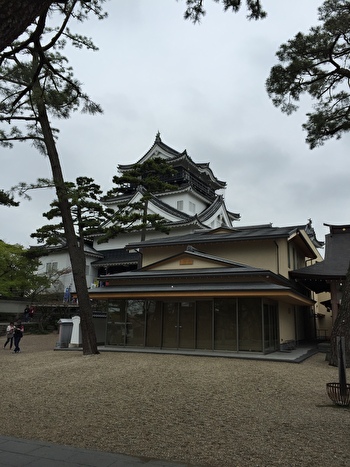岡崎公園シリーズ#02「岡崎城と徳川家康」
Do you know about Japanese parks? Okazaki Park is famous for the castle where Ieyasu Tokugawa was born. At 4T-AMKY, Teachers and Students write about Japanese culture, food, history, many spots to visit, and other stuff. Enjoy reading and knowing about deeper Japanese culture!
Okazaki Park#02 – Okazaki Castle and Ieyasu Tokugawa
History
The history of Okazaki Castle in Okazaki City, Aichi Prefecture, in chronological order, can be briefly described as follows. I have also added data related to Ieyasu Tokugawa, the founder of the Edo shogunate.
Around 1455
Yoritsugu Saigou, who was shugodai (provincial governor), built a castle on a hill called Ryutouzan, at the confluence of the Sugo and Yahagi Rivers.
1531
Kiyoyasu Matsudaira, who is Ieyasu’s grandfather, maintained the castle.
1542
Takechiyo Matsudaira, that is Ieyasu’s childhood name, was born in the castle.
Takechiyo was taken hostage by the Imagawa clan at an early age and spent his childhood in another country.
Takechiyo went through genpuku (ceremony of attaining manhood) and changed his name to Motonobu Matsudaira (1555).
1560
Yoshimoto Imagawa was defeated in the Battle of Okehazama and the Imagawa forces retreated from Okazaki Castle.
Motoyasu Matsudaira (his name changed from Motonobu to Motoyasu 1558) returned to Okazaki Castle and unified Mikawa (present Eastern half of Aichi Prefecture), using here as his base.
Motoyasu changed his name to Ieyasu (1563).
Ieyasu Matsudaira was renamed Ieyasu Tokugawa (1566).
1570
Ieyasu moved his headquarters to Hamamatsu Castle (Hamamatsu City, Shizuoka Prefecture) and placed his son, Nobuyasu in Okazaki Castle.
After Nobuyasu’s suicide, Ieyasu’s senior vassals were placed in charge of the castle as jodai (castle keeper).
1590
After Ieyasu was moved to the Kanto region by Hideyoshi Toyotomi, Yoshimasa Tanaka, a vassal of Hideyoshi, entered Okazaki Castle, expanded the castle, and built a moat (Tanaka-hori) for the overall structure.
1600
After the Battle of Sekigahara, Okazaki Castle was sanctified as the “Castle of the Birthplace of God lord Ieyasu,” and Shinpan daimyos (descendants of Ieyasu Tokugawa) and Fudai daimyos (hereditary vassals to the Tokugawa family) became the lords of the castle.
Ieyasu Tokugawa was appointed as Seii Taishogun and established the Edo Shogunate (1603).
1868
With the Meiji Restoration, the Social situation changed and most of the castles were torn down in 1873-74, as they were considered unnecessary for the new era.
1959
The current castle tower was reconstructed with the support of citizens who wanted to see it restored.
This is how the three story castle tower of Okazaki Castle with five floors was reconstructed, and today the second, third and fourth floors are used as a historical museum that tells the history of Okazaki City and Okazaki Castle. The fifth floor is an observatory with a 360-degree view of the mountains of Mikawa and Okazaki City.
The drama of how Takechiyo, born in Okazaki Castle, took the name Ieyasu and established the Edo shogunate is endlessly fascinating. In this article, I only briefly described the flow of history, focusing on the changes in Ieyasu’s name.
Okazaki Castle in the time of Lord Ieyasu almost overlaps with the present Okazaki Park. In spring, the area is known for its cherry blossoms. There are so many things to see and do in its grounds that it is impossible to introduce them all. I think the best thing to do is to come and see them for yourself.
The bronze and stone statues of Ieyasu in Okazaki Park were very impressive, so I took pictures of them. Here are some of them.

Statue of Ieyasu Tokugawa
It was built in 1965 to commemorate the “350th anniversary of the death of Ieyasu Tokugawa”. Ieyasu passed away in 1616 at the age of 75, having fulfilled his wish to unify the whole country and laid the foundation for 300 years of the Tokugawa shogunate.

Statue of Motoyasu Matsudaira
It was donated to Okazaki City at the time of the “450th Anniversary of Ieyasu’s Birth” held in 1992. The equestrian statue of the young Motoyasu (Ieyasu Tokugawa) has his back to the castle and faces the direction of Nikko Toshogu Shrine, which is being reborn as a great deity.

Stone statue of Shikamizou (A portrait depicting his agonized facial expression)
This is a stone statue based on a portrait of Ieyasu. It is a rare portrait of Ieyasu with a frown and a pained expression on his face. It is said that Ieyasu had this portrait painted, because he lost a battle and lost many of his retainers when he tried to fight an unreasonable battle against Takeda’s large army at Mikatagahara in Hamamatsu, so that he would never forget his own self-discipline. It is said to have been the foundation for the creation of the world’s leading peaceful nation.

Benches for stone statues of Lord Ieyasu and Takechiyo
These are built using the skills of Okazaki’s excellent stone craftsmen, known as the “Stone City of Okazaki,” and locally produced high-quality granite. You can actually sit next to Lord Ieyasu and Takechiyo.
岡崎公園シリーズ#02「岡崎城と徳川家康」
歴史
愛知県岡崎市にある岡崎城のあゆみを年代順に簡潔に表すと次のようになります。江戸幕府を開いた徳川家康公関連事項も付け加えました。
1455年(康正1)頃
守護代、西郷頼綱が菅生川(すごうがわ)と矢作川(やはぎがわ)の合流地点にある龍頭山(りゅうとうざん)という丘陵に築城した。
1531年(享録4)
徳川家康の祖父、松平清康が城郭整備を行った。
1542年(天文11)
松平竹千代(徳川家康の幼名)が城内で生まれた。
竹千代は幼くして今川勢の人質となり少年期を他国で過ごした。
竹千代は元服して松平元信と改名する(1555)。
1560年(永禄3)
桶狭間の戦いで今川義元が討たれ今川勢が岡崎城から退却した。
松平元康(元信から元康へ改名1558)は岡崎城に戻りここを拠点に三河(現愛知県東半部)を統一した。
元康は家康と改名する(1563)。
松平家康を徳川家康と改姓する(1566)。
1570年(元亀1)
家康は本拠を浜松城(静岡県浜松市)に移し子の信康を置いた。
信康の自刃(じじん)後は家康の重臣が岡崎城の城代として置かれた。
1590年(天正18)
家康が豊臣秀吉によって関東に移されると、秀吉の家臣田中義正が岡崎城に入り、城郭を拡張し総構(そうがまえ)の堀(田中掘)を築いた。
1600年(慶長5)
関ヶ原の戦いの後、岡崎城は「神君出生の城」として神聖化され譜代大名・親藩が城主となった。
徳川家康は征夷大将軍に任ぜられ江戸幕府を開いた(1603)。
1868年(明治元年)
明治維新を迎えると情勢が変わり、新しい時代には不要とされた城郭の大部分が1873~74(明治6~7)に取り壊された。
1959年(昭和34)
復興を望む市民の声に後押しされて現在の天守が復興された。
こうして岡崎城は3層5階建ての天守が復興となり、現在はその2階から4階までは岡崎市や岡崎城の歴史を伝える歴史資料館となっています。 5階は360度見渡せる展望台となっており、三河の山々や岡崎市を一望する事ができます。
岡崎城に生まれた竹千代が家康と名乗り江戸幕府を開くまでの様々なドラマについて興味は尽きませんが、今回は家康の名前の変遷に注目しながら歴史の流れを簡単に記すことに留めました。
家康公の時代の岡崎城はほぼ現在の岡崎公園に重なります。春には桜の名所としても知られています。その敷地内には見どころがたくさんありとても紹介しきれません。実際に足を運ばれご覧いただくくのが一番だと思います。
岡崎公園内にある家康公の銅像や石像がとても印象的だったので写真に残しました。それらを紹介します。
徳川家康公像
1965年(昭和40)に「徳川家康公350年祭」を記念して造られたものです。家康は全国統一の念願をかなえ、徳川幕政300年の基盤をも作り1616年(元和2)に75歳でこの世を去りました。
松平元康像
1992年に開催された「家康公生誕450年祭」の時に岡崎市へ寄贈されたものです。若き元康(徳川家康)の騎馬像は城を背にし、大権現として再生する日光東照宮の方角を向いています。
しかみ像
「徳川家康三方ヶ原戦役画像」をモデルとして造られた石像です。この肖像画は、浜松の三方ヶ原で武田の大軍に無理な戦いをいどみ、負け戦となって多くの家臣を失った家康が、自戒の念を忘れることのないように描かせたものと伝えられており、顔をしかめて苦渋の表情を浮かべた珍しい肖像画です。世界に冠たる平和国家を作り上げる礎になったと云われています。
家康公・竹千代像ベンチ
「石都岡崎」と呼ばれる岡崎の優秀な石職人の技術と、地元産の良質な御影石を使って造り上げられています。実際に家康公や竹千代像の隣に座ることができます。
Ikuyo.K.






